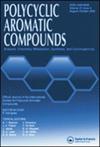Crystal Growth, Structural Elucidation, Chemical Reactivity, Topology Exploration (ELF, LOL, AIM, RDG) and NLO Activity of 4-Cumyl Phenol Crystal Using Quantum Chemical Calculation
IF 2.6
3区 化学
Q2 CHEMISTRY, ORGANIC
引用次数: 0
Abstract
The main objective of the study is to analyze the structural behavior and NLO activity of 4-cumyl phenol by experimental and theoretical spectroscopic techniques. Its computational result is compared with the cumene compound. The optimized structural parameters of the title compound were computationally obtained at the B3LYP/6-31G (d, p) basis set. The fundamental modes of vibration were examined by experimental FT-IR, and FT-Raman techniques. The distribution of the vibrational bands was carried out with the help of normal coordinate analysis (NCA). The resulting harmonic wavenumbers were scaled by using NCA method. Topological analysis, such as Electron localization function (ELF), natural bond orbital analysis (NBO), reduced density gradient (RDG) and atoms in molecule (AIM) analysis, molecular electrostatic potential (MEP) have been used to evaluate the intermolecular interaction, especially the hydrogen bonds. UV-visible spectrum of the compound was recorded in the region 200–900 nm and the electronic properties and HOMO-LUMO energies were calculated by time dependent density functional theory approach.

晶体生长、结构解析、化学反应性、拓扑探索(ELF、LOL、AIM、RDG)和NLO活性的量子化学计算
本研究的主要目的是通过实验和理论光谱技术分析4-库泊基苯酚的结构行为和NLO活性。将其计算结果与异丙烯化合物进行了比较。以B3LYP/6-31G (d, p)为基准,计算得到标题化合物的优化结构参数。通过实验FT-IR和FT-Raman技术检测了振动的基本模态。利用法向坐标分析(NCA)对结构的振带分布进行了分析。用NCA方法对得到的谐波数进行了缩放。拓扑分析如电子定位函数(ELF)、自然键轨道分析(NBO)、还原密度梯度(RDG)和分子内原子(AIM)分析、分子静电势(MEP)等已被用于评价分子间相互作用,特别是氢键。在200 ~ 900 nm范围内记录了化合物的紫外可见光谱,并利用时间依赖密度泛函方法计算了化合物的电子性质和HOMO-LUMO能量。
本文章由计算机程序翻译,如有差异,请以英文原文为准。
求助全文
约1分钟内获得全文
求助全文
来源期刊

Polycyclic Aromatic Compounds
化学-有机化学
CiteScore
3.70
自引率
20.80%
发文量
412
审稿时长
3 months
期刊介绍:
The purpose of Polycyclic Aromatic Compounds is to provide an international and interdisciplinary forum for all aspects of research related to polycyclic aromatic compounds (PAC). Topics range from fundamental research in chemistry (including synthetic and theoretical chemistry) and physics (including astrophysics), as well as thermodynamics, spectroscopy, analytical methods, and biology to applied studies in environmental science, biochemistry, toxicology, and industry. Polycyclic Aromatic Compounds has an outstanding Editorial Board and offers a rapid and efficient peer review process, as well as a flexible open access policy.
 求助内容:
求助内容: 应助结果提醒方式:
应助结果提醒方式:


